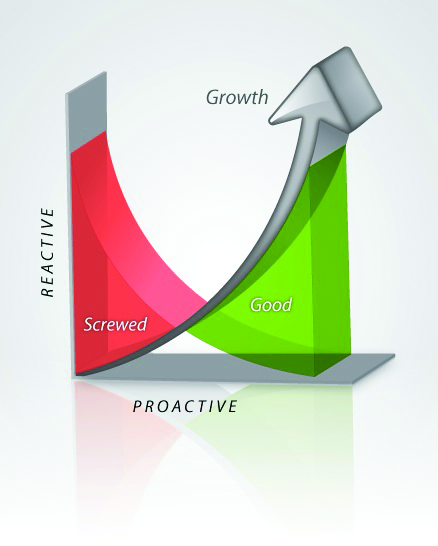Staying on the Good Side of Growth
Sep. 05, 2014

Here’s the reality. Most accounting professionals, when it comes to marketing, are highly reactive. They’ve developed some good content, have a few pieces of collateral on hand, and are sending out communications here and there. The reactive environment can be deceptive because things consistently appear to be moving along. And if things are moving, that’s good, right? Not necessarily, and here’s why.
Activity doesn’t always mean progress. Even a haphazard marketing plan can keep a firm active. However, the absence of a structured marketing program means that there is no way to quantify progress or ensure that marketing initiatives are being accomplished. The bottom line is that working reactively is just not efficient and generally means that a firm is putting in far more time than if an organized plan were in place.
The first big issue: Launching any marketing campaigns outside of a well-defined plan leaves you at high risk of some serious ball dropping. Compiling and organizing the elements that make up your broad marketing program provides a clear roadmap — complete with required deadlines and an assigned lead. As projects are completed, the plan is updated and items are checked off. This keeps everyone current on project progress through to completion. Ball dropping avoided.
The second big issue: When sending out communications outside of a plan, you lose the ability to properly track campaigns and measure their success. That is: Did the campaign reach the right audience? Are follow-up communications required and being sent? Are you getting prospects into your database? What is the rate of response? All these items are crucial to a marketing program because they provide insight on where you are successful as well as where you need to fill holes, improve your message, and step up efforts.
The proactive approach enables a firm to identify initiatives and activity over a longer period of time. And this opens up a world of value, allowing firms to do the following:
- Prepare an annual marketing budget, which helps keep costs in line.
- Identify campaigns based on defined seasonal activity (e.g., an after-tax survey to clients, an after-tax lead generation campaign to prospects, a pre-audit season initiative, etc.).
- Stay on task with each and every campaign and initiative (e.g., client newsletters, email blasts, invitations, holiday cards, networking events, etc.).
- Identify appropriate staff as lead on individual projects — allows the opportunity to assign the right staff member to projects and makes staff accountable for follow through.
- Use a single comprehensive document for easy review of progress, complete with production deadlines.
- Measure marketing goals and keep track of all activity.
Again, activity should not be confused with progress. Marketing is not random. You don’t’ just throw out communications as issues or ideas come across your plate. Marketing is, to a large degree, a science. It requires calculated attention to schedule initiatives, determine audiences, build lists, create messages, and measure and track results.
It’s important to note that proactive planning does not rule out flexibility. In fact, the best of plans need to be constantly updated, tweaked and refined. Most certainly, a plan will require changes over the course of a year. For example, you may find that your client newsletter is gaining popularity, so you up the frequency from quarterly to monthly. Or you may identify campaigns that are yielding exceptionally low response rates and decide to “can” them. Change will happen, but with a structured plan in place, it’s actually easier to maneuver change as it comes because you always know “where you are.”
Give Yourself Time to Make the Switch
Truth be told, most accounting professionals probably fall into the reactive category when it comes to marketing. And that’s certainly not due to an adversity to structure and organization. After all, this is a profession of structure. And while being proactive is ideal, you can’t simply flip a switch and go from a primarily reactive existence to one of proactive thought.
It’s recommended to start slow. Begin by investing some time in developing a broad marketing plan. Whether that’s making a list on paper of everything you want to accomplish or starting a comprehensive spreadsheet complete with action items, deadlines, and staff leads — you just need to start writing things down.
The reactive mode is counterproductive. Random efforts only leave you spinning your wheels, derailed from any sound marketing course. In a proactive environment, you always know what you are trying to achieve, and that brings about accountability and follow-through. With some effort, you can have a strong, productive and proactive marketing program in your firm.
About the Author
Kristy Short, Ed.D, is a partner in RootWorks Communications (RootWorks.com) and president of SAS Communications 360 (SAScommunications360.com)—firms dedicated to providing practice management education, branding, marketing, and public relations services to the accounting profession. She is also a professor of English and marketing. She can be reached at kristy.short@cpapracticeadvisor.com.
Possible PQs:
Marketing is, to a large degree, a science. It requires calculated attention to schedule initiatives, determine audiences, build lists, create messages, and measure and track results.
Most accounting professionals probably fall into the reactive category when it comes to marketing. And that’s certainly not due to an adversity to structure and organization.
